La música representa una de las mejores formas de expresión cultural en las comunidades indígenas de Latinoamérica; la música en la comunidad Kichwa establecida en la ciudad de Bogotá puede llegar a ser una manera de estar en contacto con su tierra natal: la provincia de Imbabura en Ecuador, pero más que eso, definen a la música como una expresión de sentimientos, contados por medio de una historia, un poema o una simple narración, sentimientos que al momento de ser captados por los demás, puede evocar una empatía colectiva, un arraigo hacia las tradiciones, un deseo de esparcimiento, que se extiende entre los propios de la comunidad, hasta quienes somos ajenos a ella, y es allí, en Imbabura, donde inicia la expansión de la música indígena a nivel latinoamericano.
Al igual que cada género musical, la música andina de la comunidad kichwa tuvo una época en la que pasó de sonar localmente a ser escuchada he interpretada en diferentes latitudes, esto fue gracias a Chopin Thermes, antropólogo y etnomusicólogo francés que recorrió casi todo el continente americano en busca de sonidos indígenas y andinos, marchando en caballo desde México hasta Guatemala y allí a Costa Rica, explorando las muestras musicales tradicionales, luego bajando en velero hasta Colombia donde recopila imágenes y sonidos vivos de las culturas indígenas nativas, principalmente la comunidad Embera y finalmente en 1969 se desplaza a pie hasta Ecuador, donde conoce Hermelinda Males, quien le mostraría a Chopin todas las comunidades Kichwa de Imbabura, y principalmente la música tradicional de cada una de ellas. Más tarde Chopin cancela su travesía hacia el Brasil, pues se enamora de Hermelinda y decide quedarse con ella para casarse y también para conocer todos los músicos de las diferentes comunidades.
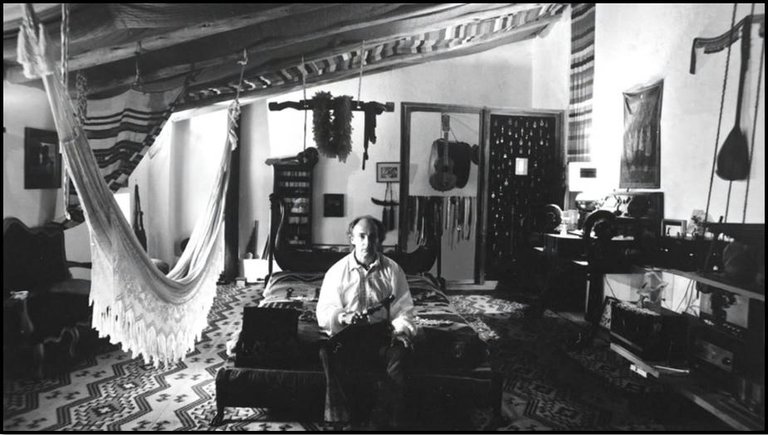
Para 1973, con los músicos Alfonso Cachiguango, Azucena Perugachi, Carlos Perugachi, Enrique Males, Juan Cayambe, Luis Enrique Pineda, Luz María Chuquín, Mariano Cachimuel, Rosa Sandoval y Zoila Saravino, Thermes empieza a grabar producir, allí inicia la agrupación de música indígena Ñanda Mañachi que significa “préstame el camino”, cuenta Chopin que esta frase le recuerda a Hermelinda, pues ella la decía cada vez que subían por los cerros (Thermes, 2013). Con el fallecimiento de Hermelinda Males durante el parto de su hija Sayana, Chopin Thermes decide sacar el primer álbum de esta reunión musical, Ñanda Mañachi 1 en 1977 y Ñanda Mañachi 2 en 1979.
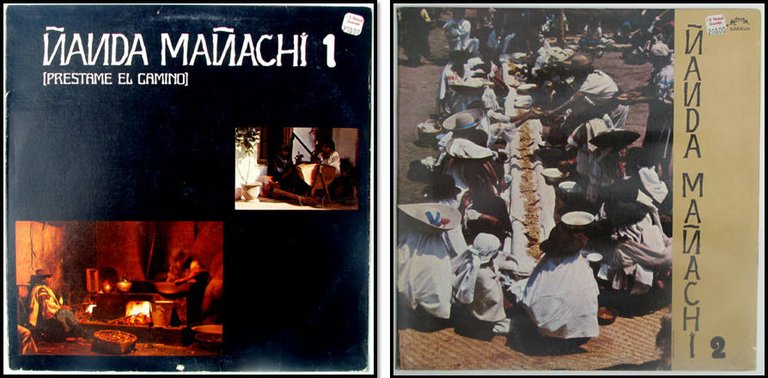
Lo que destaca a Ñanda Mañachi de otras agrupaciones Kichwa y andinas es su sonido; inicialmente se tocaba con un arpa, un golpeador (quien golpea rítmicamente la caja del arpa), el violín y quien canta; cada una de las comunidades de Imbabura como Zuleta, Caraboila, Quinchiquí, Peguche entre otras (Lema, 2013), interpretan su música tradicional de una manera diferente, algunas más rusticas, otras más suaves, unas se enfocan en el violín, otras en el arpa, pero es gracias a Chopin Thermes y Ñanda Mañachi una misma melodía conocida por todos los integrantes de la comunidad, empieza a sonar diferente, también se agrega el ritmo de la zampoña, la guitarra y el bandolín. Este disco obtuvo el premio a Mejor álbum de música Clásica de la Académie Charles Cros, en Francia.
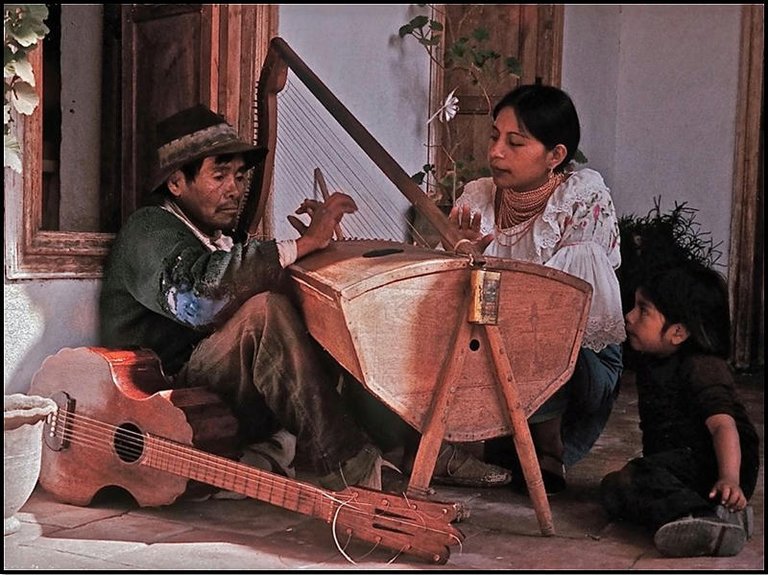
Desde entonces, Ñanda Mañachi ha sido de gran inspiración para grupos tradicionales como Centro Cultural Peguche, Walka y Ukumau, incluso empieza a ser aceptado por el resto de la sociedad ecuatoriana y se ve una fuerte influencia en intérpretes de pasillo ecuatoriano como Luis Aníbal Granja y el dueto Benítez y Valencia. Los primeros integrantes de Ñanda Mañachi ya eran mayores, como el violinista Alberto Chuquin Chilcañan, o el arpista Jatun Cayambe, quien tocaba en las puertas de la Iglesia de Otavalo a cambio de monedas, no se conocía mucho su familia y padecía una gangrena en la pierna derecha; Chopin Thermes lo encuentra y le da un lugar en Ñanda Mañachi. A Cayambe se le dificultaba tocar al mismo ritmo de los demás músicos, por lo que pasa a ser solista y hace pequeñas colaboraciones para el grupo, saca sus canciones al público con ayuda de Chopin Thermes. La música de las diferentes agrupaciones tradicionales, al ver que tiene un reconocimiento dan paso a letras de protesta y denuncia hacia todo el atropello y maltrato que recibe la comunidad indígena. Años más tarde, hacia los finales de los 80’s se crean nuevas generaciones en Ñanda Mañachi, van agregando intérpretes más jóvenes y empieza su expansión a diferentes países, no solo por parte de este grupo, sino otros grupos tradicionales son reconocidos en varios lugares de Latinoamérica, al mismo tiempo empiezan a surgir agrupaciones acá en Colombia, como el grupo Ukumau o Walka que recientemente tuvo una gira por Japón, situación que nos permite ver lo lejos que ha llegado la música andina mientras que los grupos tradicionales como Ñanda Mañachi y Centro Cultural Peguche aún conservan la intención de reavivar las costumbres kichwas por medio de la herencia por parte de las pasadas generaciones a jóvenes que aún se interesan en este ideal.
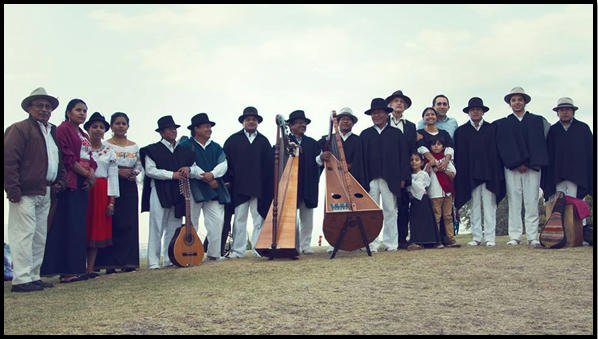
La música kichwa se caracteriza por contar historias personales, quien compone narra sus experiencias y luego las expresa en las canciones, se hablan de historias de fiestas como el Chuchaki que significa Resaca del maestro taita Alejandro Torán o de amor en Río del Tahuando de la compositora Rosita Sandoval (Lema, 2013). La música andina en general estaba ligada socialmente a las comunidades más pobres de Ecuador, el imaginario cultural de quienes escuchaban la música andina se relacionaba a sujetos de bajos recursos, indígenas primitivos, lo rural y no civilizado, por esta razón las comunidades indígenas limitaban sus presentaciones, reuniones y celebraciones, pues no tenían espacios fuera de allí para interpretar sus cantos. Un grupo de música tradicional kichwa estaba conformado por un arpista, un golpeador (sujeto que golpea la caja inferior del arpa al ritmo de la canción), un violinista y el cantante que también podía tocar algún instrumento, estos son los roles asignados a los hombres, mientras que las mujeres se encargaban del coro en un tono muy agudo. Esta formación musical se mantuvo durante décadas con estos instrumentos, mientras que cada una de las comunidades kichwa se fueron especializando en un instrumento y en un modo diferente de tocar, allí se podían agregar otros instrumentos como la zampoña, la guitarra o el bandolín.
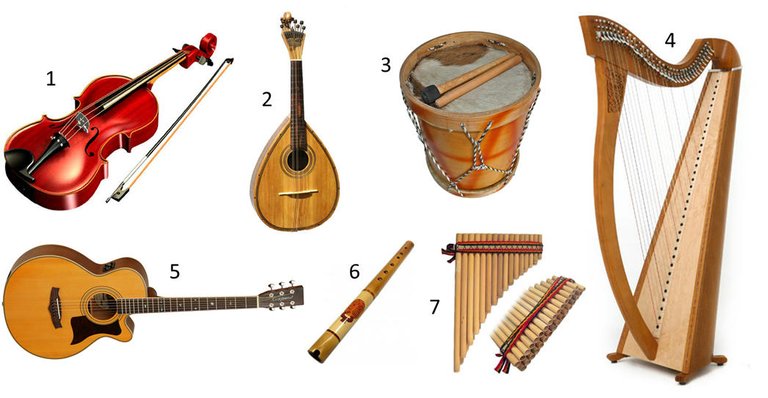
Por otro lado, la situación musical de la comunidad kichwa de a pie en Bogotá es completamente diferente. Durante una visita a la carrera séptima en el centro de Bogotá, al Parque Nacional Enrique Olaya Herrera, al Parque Lourdes en la localidad de Chapinero o al Chorro de Quevedo en la localidad de Candelaria es muy común encontrarse con alguna representación musical de cualquier etnia, pero estas son medidas que toman aquellos que tienen conocimiento en algún instrumento para poder ganar algo de dinero. Durante estas presentaciones es muy común encontrar que los músicos son generalmente hombres, la presencia de las mujeres es casi nula. Estas exhibiciones tienen elementos que pueden variar según los grupos que toquen, hay quienes tienen herramientas de sonido como micrófonos, parlantes y amplificadores para una óptima exposición, también tienen una vestimenta típica de la comunidad, en el caso de la comunidad kichwa sus trajes masculinos son una ruana y un sombrero negro, la camisa, el pantalón y las alpargatas blancas. Estos grupos normalmente interpretan canciones compuestas por ellos mismos en español o únicamente ritmos instrumentales. En cambio, otros grupos tocan sin ninguna ayuda electrónica, con la vestimenta tradicional y las canciones pueden ser instrumentales, compuestas por ellos mismos o algún ritmo nacional como el bambuco, el torbellino o la guabina; normalmente son los grupos con mejor dotación quienes atraen más personas y recolectan más dinero, en algunos casos los espectadores toman fotos y graban las exposiciones; mientras que los otros grupos con menos herramientas atraen menos espectadores, recolectan menos dinero y pueden no tener el mismo acogimiento por quienes se desenvuelven en el sector que tocan como comerciantes callejeros y transeúntes.
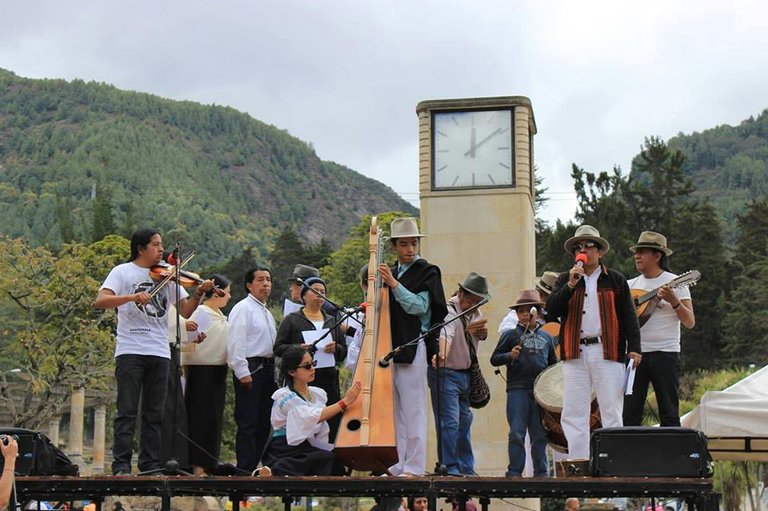
La comunidad bogotana es testigo de las expresiones de la música andina en diferentes partes de la ciudad, grupos tradicionales hacen conciertos en lugares como la media torta, el chorro de Quevedo o el parque nacional, en cada una de estas presentaciones la acogida por parte del público capitalino crea un ambiente de fiesta y alegría, hay quienes aplauden, mueven el cuerpo, cantan los versos recién aprendidos y hasta se levantan a bailar pasos de música carranguera (ritmo musical del departamento de Boyacá Colombia), la gente se cautiva por la manera de vestir de los músicos, por la peculiaridad del sonido de cierto instrumento al que estamos acostumbrados escuchar de manera diferente, por las voces del coro. Alrededor de estas presentaciones no predomina ningún grupo de personas, a donde miremos estará un joven, un anciano, un niño, una mujer, un indígena, un campesino, cualquier persona que se vea atraída por esa música que todos reconocemos como nuestra pero que muchos no frecuentamos en nuestros celulares.
Lastimosamente estas presentaciones a pesar de ser muy llamativas, no son las que estamos familiarizados a ver, en zonas como la carrera séptima o la plaza de la mariposa en San Victorino es común ver presentaciones de música kichwa o tradicional a cambio de monedas o alimento, algunas tal vez esperando correr la misma suerte de Jatun Cayambe y ser encontrados por algún músico o empresario que lo catapulte a la fama con sus letras y su instrumento, pero es eso lo que hace perder la esencia de la música kichwa compuesta décadas atrás, donde lo que se buscaba era reavivar los ritmos ancestrales, convocar a la unión y el esparcimiento, festejar con la infaltable chicha mientras se contaban anécdotas de las que podía reír, llorar o recordar; por eso es que grupos como Ñanda Mañachi o el Centro Cultural Peguche extienden su música a lugares como Bogotá reclutando jóvenes que desean aprender de la herencia dejada por las primeras generaciones musicales y al mismo tiempo reavivar nuestra cultura indígena nativa.
¡GRACIAS POR TU VOTO! NOS VEMOS EN EL LADO OSCURO DE LA LUNA ☾
KICHWA INDIGENOUS AND THEIR ARRIVAL TO BOGOTA. VOL 2 - MUSICAL EXPERSSION
Music represents one of the best forms of cultural expression in the indigenous communities of Latin America; Music in the Kichwa community established in the city of Bogotá is a way of being in touch with its native land: the province of Imbabura in Ecuador, but more than that, defining music as an expression of feelings counted through a Story, a poem or a simple narration, feelings that at the moment of being captured by the others, can evoke a collective empathy, a rootedness to the traditions, a desire for recreation, that extends among the own ones of the community, and is there , In Imbabura, where the expansion of indigenous music begins at the Latin American level.
Like every musical genre, the Andean music of the Kichwa community had a time when it went from locally sounding to being heard and interpreted in different latitudes, this was thanks to Chopin Thermes, anthropologist and French ethnomusicologist who toured almost the entire continent American in search of indigenous and Andean sounds, marching on horseback from Mexico to Guatemala and there to Costa Rica, exploring traditional musical samples, then sailing down to Colombia where he collected images and live sounds of indigenous native cultures, mainly the Emberá community And finally in 1969 he moved on foot to Ecuador, where he met Hermelinda Males, who would show Chopin all the Kichwa communities of Imbabura, and especially the traditional music of each one. Later Chopin cancels his trip to Brazil, because he falls in love with Hermelinda and decides to stay with her to get married and also to meet all musicians from different communities

In 1973, with the musicians Alfonso Cachiguango, Azucena Perugachi, Carlos Perugachi, Enrique Males, Juan Cayambe, Luis Enrique Pineda, Luz María Chuquín, Mariano Cachimuel, Rosa Sandoval and Zoila Saravino, Thermes begins to record produce, there begins the grouping of music Indigenous Ñanda Mañachi which means "lend me the way," Chopin says that this phrase reminds Hermelinda, as she said every time they climbed the hills. With the death of Hermelinda Males during the birth of her daughter Sayana, Chopin Thermes decides to take the first album of this musical meeting, Ñanda Mañachi 1 in 1977 and Ñanda Mañachi 2 in 1979.

What highlights Ñanda Mañachi from other Kichwa and Andean groups is their sound; Initially played with a harp, a kicker (who rhythmically hits the harp box), the violin and who sings; Each of the communities of Imbabura as Zuleta, Caraboila, Quinchiquí, Peguche among others, interpret their traditional music in a different way, some more rustic, some more soft, some focus on the violin, others on the harp, but it is thanks Chopin Thermes and Ñanda Mañachi the same melody known by all members of the community, begins to sound different, also added the rhythm of the zampoña, guitar and mandolin. This album won the prize for Best classical music album of the Académie Charles Cros, in France.

Since then, Ñanda Mañachi has been a great inspiration for traditional groups such as Centro Cultural Peguche, Walka and Ukumau. It even begins to be accepted by the rest of Ecuadorian society and a strong influence is seen in interpreters of the Ecuadorian Pasillo (traditional rhythm) as Luis Aníbal Granja and the duet Benítez and Valencia. The first members of Ñanda Mañachi were already older, like the violinist Alberto Chuquin Chilcañan, or the harpist Jatun Cayambe who played at the doors of the Church of the city of Otavalo in exchange for coins, did not know much of his family and suffered a Gangrene in the right leg; When Chopin Thermes found him, he gave him a place in Ñanda Mañachi. Cayambe had difficulty playing at the same rhythm as the other musicians, so he became a soloist and made small collaborations for the group, he released his songs to the audience with the help of Chopin Thermes.
When the music of the different traditional groups has a recognition, these groups give way to letters of protest and denunciation towards all the abuses and mistreatment that the indigenous community receives. Years later, at the end of the 80's, new generations were created in Ñanda Mañachi, adding younger interpreters and beginning their expansion to different countries, not only by this group, but other traditional groups are recognized in several places in Latin America , At the same time begin to appear groups here in Colombia, such as the group Ukumau or Walka who recently toured Japan, a situation that allows us to see how far Andean music has come.

Kichwa music is characterized by telling personal stories, who composes narrates their experiences and then expresses them in the songs, talk about stories of parties such as the Chuchaki that means hangover by Taita Alejandro Torán or love in the river Tahuando by the composer Rosita Sandoval. Andean music in general was socially linked to the poorer communities of Ecuador, the cultural imagery of those who listened to Andean music was related to low-resource subjects, primitive Indians, the rural and uncivilized, for this reason the indigenous communities limited their Presentations, meetings and celebrations, because they had no spaces outside to interpret their songs.
The conformation of a group of traditional Kichwa music has not changed much, was formed by a harpist, a kicker (subject who hits the lower case of the harp to the rhythm of the song), a violinist and the singer who could also play some instrument, These are the roles assigned to the men, while the women were in charge of the choir in a very keen tone. This musical formation was maintained for decades with these instruments, while each of the Kichwa communities specialized in an instrument and in a different way of playing, other instruments could be added there like the zampoña, the guitar or the mandolin.

Currently Kichwa music has exhibitors of different types, we find those who use their talent for entertainment and commercial purposes, such as the Bogotan groups Walka and Ukumau; While traditional groups such as Ñanda Mañachi and Centro Cultural Peguche still retain the intention to revive Kichwa customs by means of the inheritance of the past generations to young people who are still interested in this ideal.
On the other hand, the musical situation of the Kichwa community of Bogotá is completely different. During a visit to the seventh avenue in the center of Bogota, to the National Park Enrique Olaya Herrera, to the Lourdes Park in the locality of Chapinero or to the Chorro de Quevedo in the locality of Candelaria is very common to be with some musical representation of any ethnic group, But these are measures that take those who have knowledge in some instrument to be able to earn some money. During these presentations it is very common to find that musicians are generally men, the presence of women is almost nil. These exhibits have elements that can vary depending on the groups they play, there are those who have sound tools like microphones, speakers and amplifiers for optimal exposure, they also have a typical community outfit, in the case of the Kichwa community their male suits are A ruana and a black hat, shirt, trousers and white espadrilles. These groups usually interpret songs composed by themselves in Spanish or only instrumental rhythms. On the other hand, other groups play without any electronic help, with the traditional dress and the songs can be instrumental, composed by themselves or some national rhythm like the bambuco, the torbellino or the guabina; It is usually the best-endowed groups who attract more people and collect more money, in some cases viewers take photos and record exhibits; While the other groups with fewer tools attract fewer viewers, collect less money and may not have the same support by those who operate in the sector as street traders and pedestrians.

The Bogota community witnesses expressions of Andean music in different parts of the city, traditional groups make concerts in places such as the half-cake, Quevedo stream or the national park, in each of these presentations the reception by the Public creates an atmosphere of celebration and joy, there are those who applaud, move the body, sing the newly learned verses and even get up to dance steps of music carranguera (musical rhythm of the department of Boyacá Colombia), people are captivated by the way Dress of the musicians, by the peculiarity of the sound of a certain instrument to which we are accustomed to listen in a different way, by the voices of the choir. Around these presentations do not predominate any group of people, where we will be a young man, an old man, a boy, a woman, an Indian, a peasant, anyone who is attracted by that music that we all recognize as ours but that many We do not frequent our cell phones.
Unfortunately these presentations, despite being very striking, are not the ones we are familiar to see, in areas such as the seventh avenue or the Plaza de la Mariposa in San Victorino it is common to see presentations of Kichwa or traditional music in exchange for coins or food, Some perhaps hoping to take the same fate as Jatun Cayambe and be found by some musician or businessman to bring him to fame with his lyrics and his instrument, but that is what makes it lose the essence of kichwa music composed decades ago where It was sought to revive the ancestral rhythms, to summon union and recreation, to celebrate with the infallible chicha (traditional drink fermented with maize) while telling anecdotes of which he could laugh, mourn or remember; That's why groups such as Ñanda Mañachi or Centro Cultural Peguche extend their music to places like Bogota by recruiting young people who want to learn from the heritage left by the first musical generations and at the same time revive our native indigenous culture.
¡Wow! Sin duda alguna en Steemit aprendes muchas cosas nuevas :). Voy a ver si doy con los álbumes mencionados en YouTube. Me dieron ganas de escucharlo.
Congratulations @cesarbauleo! You received a personal award!
You can view your badges on your Steem Board and compare to others on the Steem Ranking
Vote for @Steemitboard as a witness to get one more award and increased upvotes!